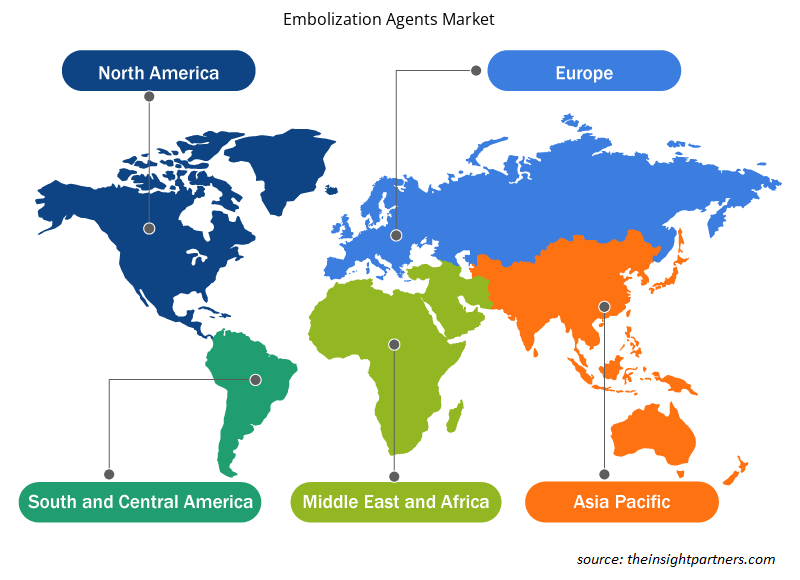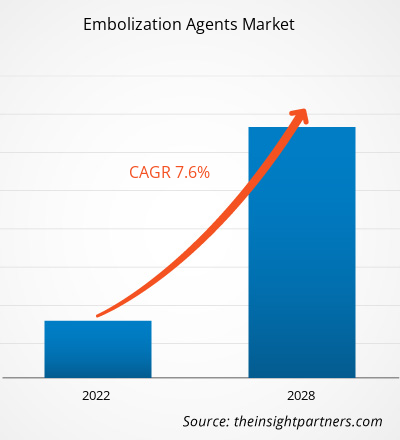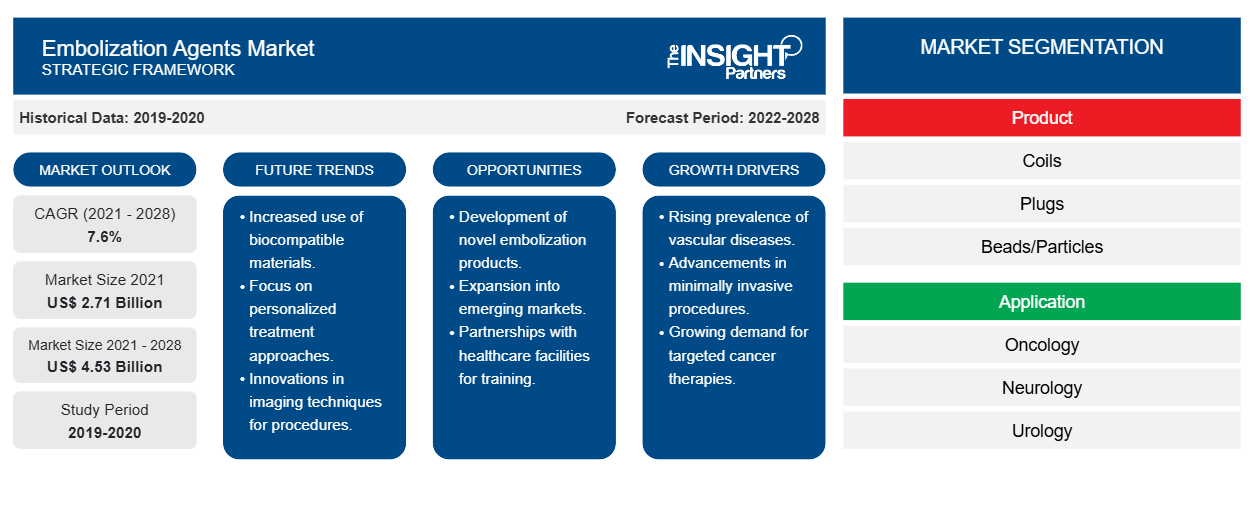Si prevede che il mercato degli agenti di embolizzazione raggiungerà i 4.525,75 milioni di dollari entro il 2028, rispetto ai 2.714,82 milioni di dollari del 2021; si prevede una crescita a un CAGR del 7,6% dal 2021 al 2028.
La crescita del mercato è attribuita alla crescente incidenza di tumori e aneurismi e alla crescente prevalenza di ipertensione, obesità, fumo e alcolismo. Tuttavia, gli elevati costi degli agenti di embolizzazione frenano la crescita del mercato degli agenti di embolizzazione . Gli agenti di embolizzazione vengono utilizzati per applicare un'occlusione meccanica per interrompere il flusso di sangue in un vaso sanguigno o in un'area vascolare. Nella radiologia interventistica, l'embolizzazione è una procedura comune. Le procedure di embolizzazione vengono utilizzate principalmente per trattare lesioni traumatiche. Gli agenti embolici si presentano in una varietà di forme, ciascuna con il proprio set di proprietà e applicazioni. A seconda della durata richiesta per l'occlusione arteriosa, gli agenti di embolizzazione sono classificati come temporanei o permanenti.
Negli Stati Uniti, la domanda di procedure di trattamento delle verruche si è ridotta a causa dello spostamento dell'attenzione sul trattamento del COVID-19. La pandemia di COVID-19 ha causato scompiglio nelle catene di fornitura globali, nei mercati dei consumatori e nelle economie. Questa situazione ha portato a un calo delle procedure cardiache eseguite in vari paesi dell'Asia Pacifica. Le misure attuate dai governi di tutto il mondo hanno avuto un impatto negativo sulla crescita del mercato degli agenti per embolizzazione.
Personalizza questo report in base alle tue esigenze
Riceverai la personalizzazione gratuita di qualsiasi report, comprese parti di questo report, o analisi a livello nazionale, pacchetto dati Excel, oltre a usufruire di grandi offerte e sconti per start-up e università
-
Scopri le principali tendenze di mercato in questo rapporto.Questo campione GRATUITO includerà analisi di dati che spaziano dalle tendenze di mercato alle stime e alle previsioni.
Approfondimenti di mercato
L'aumento dell'incidenza di tumori e aneurismi alimenta la crescita del mercato degli agenti di embolizzazione
Secondo il National Cancer Institute, nel 2020, negli Stati Uniti si sono verificati 1.806.590 nuovi casi di cancro e 606.520 decessi dovuti alla malattia. Nel 2020, i tumori alla prostata, ai polmoni e al colon-retto hanno rappresentato il 43% di tutti i tumori diagnosticati negli uomini. I tumori al seno, ai polmoni e al colon-retto sono i tre tumori più frequenti diagnosticati nelle donne. Secondo il rapporto della Brain Aneurysm Foundation, Statistics and Facts, negli Stati Uniti, circa 6,5 milioni di persone, ovvero 1 persona su 50, ha un aneurisma cerebrale non rotto. Ha anche menzionato che il 20% delle persone totali a cui è stato diagnosticato un aneurisma cerebrale ha più di un aneurisma. Ha inoltre riferito che, ogni anno, circa 30.000 persone negli Stati Uniti soffrono di una rottura di aneurisma cerebrale e una rottura di aneurisma cerebrale si verifica ogni 18 minuti. Inoltre, secondo l'NHS, ogni anno nel Regno Unito, 1 persona su 12.500 ha un aneurisma cerebrale rotto in Inghilterra. Inoltre, secondo il rapporto "Unruptured Intracranial Aneurysms Pathogenesis and Individualized Management" pubblicato su Deutsches Ärzteblatt International nel 2020, circa 2 milioni di persone (adulti) in Germania hanno un aneurisma intracranico (IA) non rotto. Gli agenti di embolizzazione vengono utilizzati per interrompere in modo acuto il flusso in un vaso sanguigno o territorio vascolare mediante occlusione meccanica. Gli agenti embolizzanti, come le microsfere emboliche (perle), vengono utilizzati per limitare l'afflusso vascolare ai tumori e possono essere caricati con farmaci chemioterapici, che eluiscono e si diffondono nel tessuto. Gli agenti embolici liquidi vengono utilizzati per impedire l'afflusso di sangue all'aneurisma o al tumore. Pertanto, la crescente prevalenza di aneurismi e tumori sta determinando una forte domanda di agenti di embolizzazione.
Approfondimenti basati sui prodotti
In base al prodotto, il mercato degli agenti di embolizzazione è segmentato in spirali, perle/particelle, tappi, palloncini staccabili, colla, spugna, embolici liquidi, sclerosanti, agenti precipitanti e altri. Il segmento perle/particelle detiene la quota maggiore del mercato. Tuttavia, si prevede che il segmento delle spirali registrerà il CAGR più elevato nel periodo 2021-2028. L'embolizzazione a spirale è una procedura basata su catetere che consente l'occlusione precisa del flusso sanguigno anomalo in un vaso sanguigno. Il crescente numero di interventi chirurgici cardiaci sta spingendo la crescita del mercato di questo segmento.
Approfondimenti basati sulle applicazioni
In base all'applicazione, il mercato degli agenti di embolizzazione è segmentato in neurologia, oncologia, cardiologia, malattie vascolari periferiche e altri. Il segmento oncologico detiene la quota maggiore del mercato e si prevede che registrerà il CAGR più elevato nel mercato durante il periodo di previsione.
Informazioni basate sull'utente finale
In base all'utente finale, il mercato degli agenti di embolizzazione è segmentato in ospedali, centri chirurgici ambulatoriali, centri cardiaci e altri. Il segmento degli ospedali detiene la quota di mercato più grande e si stima che registrerà il CAGR più elevato durante il periodo di previsione. La crescita del mercato per questo segmento è attribuita al crescente numero di ospedali in tutto il mondo e al numero in rapida crescita di procedure chirurgiche.
Le aziende che operano nel mercato degli agenti di embolizzazione stanno adottando la strategia di innovazione di prodotto per soddisfare le mutevoli richieste dei clienti in tutto il mondo, il che consente loro anche di mantenere il proprio marchio nel mercato globale.
Informazioni regionali sul mercato degli agenti di embolizzazione
Le tendenze regionali e i fattori che influenzano il mercato degli agenti di embolizzazione durante il periodo di previsione sono stati ampiamente spiegati dagli analisti di Insight Partners. Questa sezione discute anche i segmenti e la geografia del mercato degli agenti di embolizzazione in Nord America, Europa, Asia Pacifico, Medio Oriente e Africa e Sud e Centro America.

- Ottieni i dati specifici regionali per il mercato degli agenti di embolizzazione
Ambito del rapporto di mercato sugli agenti di embolizzazione
| Attributo del report | Dettagli |
|---|---|
| Dimensioni del mercato nel 2021 | 2,71 miliardi di dollari USA |
| Dimensioni del mercato entro il 2028 | 4,53 miliardi di dollari USA |
| CAGR globale (2021 - 2028) | 7,6% |
| Dati storici | 2019-2020 |
| Periodo di previsione | 2022-2028 |
| Segmenti coperti |
Per Prodotto
|
| Regioni e Paesi coperti |
America del Nord
|
| Leader di mercato e profili aziendali chiave |
|
Densità degli attori del mercato: comprendere il suo impatto sulle dinamiche aziendali
Il mercato degli agenti di embolizzazione sta crescendo rapidamente, spinto dalla crescente domanda degli utenti finali dovuta a fattori quali l'evoluzione delle preferenze dei consumatori, i progressi tecnologici e una maggiore consapevolezza dei benefici del prodotto. Con l'aumento della domanda, le aziende stanno ampliando le loro offerte, innovando per soddisfare le esigenze dei consumatori e capitalizzando sulle tendenze emergenti, il che alimenta ulteriormente la crescita del mercato.
La densità degli operatori di mercato si riferisce alla distribuzione di aziende o società che operano in un particolare mercato o settore. Indica quanti concorrenti (operatori di mercato) sono presenti in un dato spazio di mercato in relazione alle sue dimensioni o al valore di mercato totale.
Le principali aziende che operano nel mercato degli agenti di embolizzazione sono:
- Medtronic
- Società Terumo
- Cuoco Medico LLC
- Società scientifica di Boston
- Abate
Disclaimer : le aziende elencate sopra non sono classificate secondo un ordine particolare.

- Ottieni una panoramica dei principali attori del mercato degli agenti di embolizzazione
Mercato degli agenti di embolizzazione – per prodotto
-
Bobine
- Bobine staccabili
- Bobine spingibili
-
Perline/Particelle
- Sferico
- Non sferico
- Spine
- Palloncini staccabili
- Colla
- Spugna
- Embolici liquidi
- Sclerosanti
- Agenti precipitanti
- Altri
Mercato degli agenti di embolizzazione – per applicazione
- Oncologia
- Neurologia
- Urologia
- Cardiologia
- Malattie vascolari periferiche
- Altri
Mercato degli agenti di embolizzazione – per utente finale
- Ospedali
- Centri Cardiologici
- Centri chirurgici ambulatoriali
- Altri
Mercato degli agenti di embolizzazione – per area geografica
-
America del Nord
- NOI
- Canada
- Messico
-
Europa
- Francia
- Germania
- Italia
- Regno Unito
- Spagna
- Resto d'Europa
-
Asia Pacifico (APAC)
- Cina
- India
- Corea del Sud
- Giappone
- Australia
- Resto dell'APAC
-
Medio Oriente e Africa (MEA)
- Sudafrica
- Arabia Saudita
- Emirati Arabi Uniti
- Resto del MEA
-
America del Sud e Centro (SCAM)
- Brasile
- Argentina
- Resto della TRUFFA
Profili aziendali
- Medtronic
- Società Terumo
- Cuoco Medico LLC
- Società scientifica di Boston
- Abate
- Società per azioni Stryker
- Penumbra, Inc.
- Sistemi medici Merit Inc.
- Sintesi DePuy
- CORPORAZIONE KANEKA
- Analisi storica (2 anni), anno base, previsione (7 anni) con CAGR
- Analisi PEST e SWOT
- Valore/volume delle dimensioni del mercato - Globale, Regionale, Nazionale
- Industria e panorama competitivo
- Set di dati Excel
Report recenti
Testimonianze
Motivo dell'acquisto
- Processo decisionale informato
- Comprensione delle dinamiche di mercato
- Analisi competitiva
- Analisi dei clienti
- Previsioni di mercato
- Mitigazione del rischio
- Pianificazione strategica
- Giustificazione degli investimenti
- Identificazione dei mercati emergenti
- Miglioramento delle strategie di marketing
- Aumento dell'efficienza operativa
- Allineamento alle tendenze normative























 Ottieni un campione gratuito per - Mercato degli agenti di embolizzazione
Ottieni un campione gratuito per - Mercato degli agenti di embolizzazione